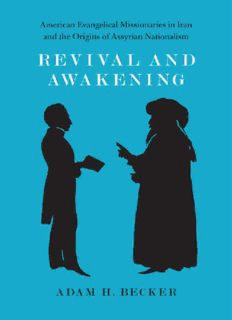
Revival and Awakening: American Evangelical Missionaries in Iran and the Origins of Assyrian Nationalism PDF
Preview Revival and Awakening: American Evangelical Missionaries in Iran and the Origins of Assyrian Nationalism
Revival and Awakening Revival and Awakening American Evangelical Missionaries in Iran and the Origins of Assyrian Nationalism Adam H. Becker The University of Chicago Press Chicago and London Adam H. Becker is associate professor of religious studies and classics at New York University. He is the author of Fear of God and the Beginning of Wisdom. The University of Chicago Press, Chicago 60637 The University of Chicago Press, Ltd., London © 2015 by The University of Chicago All rights reserved. Published 2015. Printed in the United States of America 24 23 22 21 20 19 18 17 16 15 1 2 3 4 5 ISBN- 13: 978- 0- 226- 14528- 0 (cloth) ISBN- 13: 978- 0- 226- 14531- 0 (paper) ISBN- 13: 978- 0- 226- 14545- 7 (e- book) DOI: 10.7208/chicago/9780226145457.001.0001 Library of Congress Cataloging- in- Publication Data Becker, Adam H., 1972– author. Revival and awakening : American evangelical missionaries in Iran and the origins of Assyrian nationalism / Adam H. Becker. pages ; cm Includes bibliographical references and index. ISBN 978- 0- 226- 14528- 0 (cloth : alk. paper) — ISBN 978- 0- 226- 14531- 0 (pbk. : alk. paper) — ISBN 978- 0- 226- 14545- 7 (e- book) 1. Missions to Assyrian Church of the East members—History—19th century. 2. Protestant churches—Missions—Iran— History—19th century. 3. Missionaries—United States—History—19th century. 4. Evangelistic work—Iran—History—19th century. 5. Syriac Christians—Iran— Religion—History—19th century. 6. Assyrian Church of the East members— History—19th century. 7. Nationalism—Religious aspects—Christianity—History— 19th century. I. Title. BV2628.N4B43 2015 266'.02373055—dc23 2014019847 o This paper meets the requirements of ANSI/NISO Z39.48- 1992 (Permanence of Paper). Patri Matrique (hac in serie, Michael). Contents Prelude: A Song of Assyria ix Acknowledgments xv Note on Transliteration and Names xvii Introduction: Religious Reform, Nationalism, and Christian Mission 1 1 The Church of the East before the Modern Missionary Encounter: Historicizing Religion before “Religion” 37 2 A Residence of Eight Years in Persia (1843): Mr. Perkins of West Springfield, Massachusetts, meets Mar Yokhannan of Gawilan, Persia 71 3 Printing the Living Word: Moral Reform and the Awakening of Nation and Self (1841– 70) 102 4 Being Together in the Living Word: The Mission and Evangelical Sociality (1834– 70) 137 5 Death, the Maiden, and Dreams of Revival 181 6 National Contestation and Evangelical Consciousness: The Journals of Native Assistants 223 7 Continuity and Change in the Late Nineteenth Century: New Institutions, Missionary Competition, and the First Generation of Nationalists 257 8 Retrieving the Ruins of Nineveh: Language Reform, Orientalizing Autoethnography, and the Demand for National Literature 299 Epilogue: Mirza David George Malik (1861– 1931) and the Engaged Ambivalence of Poetry in Exile 339 Notes 359 Bibliography 399 Index 419 Prelude: A Song of Assyria I have a music video to thank for the origins of this project. Around the year 2000 I discovered Juliana Jendo’s “Alap Bet,” a song and video that aim to teach the Christian Aramaic alphabet.1 Jendo, an Assyrian pop singer, origi- nally hails from Tel Tamer, a village north of Hassake in Syria. Assyrian Christians settled in this part of eastern Syria in the 1930s after many were expelled from the new state of Iraq. Some of those expelled were already refu- gees from what is now Turkey due to the expulsion of Assyrians during World War I, an event simultaneous with and related to the better-k nown Armenian genocide. In 1980 Jendo and her family came to Chicago, where a large Assyr- ian community remains today. The lyrics of the song, which I translate here from Neo-A ramaic, begin: “alap: Assyria is our mother / bet: Mesopotamia is our country. We have one language and these are our letters.” The first lines have an alliterative acrostic play: the word for “Assyria,” ator, begins with alap, the first letter of the Assyr- ian alphabet, whereas bet, the second letter, is part of the word for “Mesopo- tamia,” bet nahrain (lit. “the place of the rivers,” originally meaning “between the rivers”). The twenty- two letters of the alphabet are then chanted, a series that is repeated in the song’s refrain. Each individual letter of the alphabet receives special attention in the song as a series of words that begin with that letter are listed— alap alaha ata (alap: then the words for “God,” “flag”), bet baba bruna brata (bet: “father,” “son,” “daughter”)— and the lyrics continue through the whole alphabet alliteratively listing words from the mundane (“world” and “wealth”) to abstractions, practices, and social figures relevant to the community (“love,” “freedom,” “fasts,” “prayers,” “teachers,” and “mar- tyrs”). During the introductory credits of the accompanying video, which include Jendo’s name in English and Aramaic, a winged ancient Assyrian bull
Description: